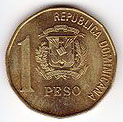|


The Dominican peso, also called peso oro ("gold peso") is the currency of the Dominican Republic. Its symbol is "$", with "RD$" used when distinction from other pesos (or dollars) is required; its ISO 4217 code is "DOP". Each peso is divided into 100 centavos ("cents"), for which the ¢ symbol is used. It is the only currency which is legal tender for all monetary transactions, whether public or private, in the Dominican Republic.
History
The first Dominican peso was introduced with the country's independence from Haiti in 1844. It replaced the Haitian gourde at par and was divided into 8 reales. The Dominican Republic decimalized in 1877, subdividing the peso into 100 centavos. A second currency, the franco, was issued between 1891 and 1897 but did not replace the peso. However, in 1905, the peso was replaced by the U.S. dollar, at a rate of 5 pesos to the dollar. The peso oro was introduced in 1937 at par with the U.S. dollar, although the dollar continued to be used alongside the peso oro until 1947.
Coins
First peso, 1844–1905
Only one denomination of coin was issued by the Dominican Republic before decimalization. This was the ¼ real, issued in 1844 in bronze and in both 1844 and 1848 in brass. Decimalization in 1877 brought about the introduction of three new coins, the 1, 2½ and 5 centavos. 1¼ centavo coins were also issued between 1882 and 1888. After the franco was abandoned, silver coins were introduced in 1897 in denominations of 10 and 20 centavos, ½ and 1 peso. The designs of these coins were very similar to those of the franco.
Peso Oro, from 1937
Coins were introduced in 1937 in denominations of 1, 5, 10, 25 centavos and ½ pesos with small numbers of 1 peso coins first minted in 1939. The full name of the currency has never appeared on coins, only "peso". Base metal replaced silver in the higher denominations in 1967. Since 1991, coins of denominations of 5, 10 and 25 pesos have been introduced. However, due to chronic inflation, coins below 1 peso are now rarely found.
Banknotes
First peso, 1844–1905
Paper money made up the bulk of circulating currency for the first peso. Provisional issues of 40 and 80 pesos were produced in 1848, followed by regular government notes for 1, 2 and 5 pesos in 1849, and 10 and 50 peso notes in 1858. The Comision de Hacienda issued 50 and 200 pesos in 1865, whilst the Junta de Credito introduced notes for 10 and 20 centavos that year, followed by 5 and 40 centavos in 1866 and 1, 2, 5 and 10 pesos in 1867. In 1862, the Spanish issued notes for ½, 2, 5, 15 and 25 pesos in the name of the Intendencia de Santo Domingo. The last government notes were 1 peso notes issued in 1870.
Two private banks issued paper money. The Banco Nacional de Santo Domingo issued notes between 1869 and 1889 in denominations of 25 and 50 centavos, 1, 2, 5, 10, 20, 25 and 100 pesos. The Banco de la Compañia de Crédito de Puerto Plata issued notes from the 1880s until 1899 in denominations of 25 and 50 centavos, 1, 2, 5, 10 and 50 pesos. Note that the Banco Nacional de Santo Domingo also issued notes in 1912 denominated in dollars (called pesos in the Spanish text).
Peso Oro, from 1947
When the peso oro was introduced in 1937, no paper money was made and US notes continued to circulate. Only in 1947 were the first peso oro notes issued by the Central Bank in denominations of 1, 5, 10, 20, 50, 100, 500 and 1000 pesos oros. In 1961, low value notes were issued in denominations of 10, 25 and 50 centavos. 2000 peso oro notes were introduced in 2000.
Banknotes currently in circulation are 50, 100, 200, 500, 1000 and 2000 pesos oros. The 10 and 20 peso denomination bills have been replaced with 10 and 25 coins respectively. In 2010, a new 20 pesos oro polymer banknote was released. Limited editions of the 500 and 2000 peso oro notes were issued for the 1992 500th anniversary of the discovery of the Americas and year 2000 millennial celebrations, respectively, but as of 2005 not many of these remain in circulation.
All banknotes carry the phrase "Este billete tiene fuerza libertoria para el pago de todas las obligaciónes públicas o privadas". Literally translated, (Spanish: This bill has the liberatory strength to be used as payment for all public or private obligations).
2010
New polymer 20 banknote.
Relation with the U.S. dollar
The United States dollar is used as a reserve currency by the Dominican Central Bank. Also, when convened by both parties, both U.S. dollars and the euro can be used in private transactions (this applies mostly in tourism-related activities). This was most true during the drastic inflationary period of 2003–2004.
Historical exchange rates
Historically, since the first monetary emission in 1948, the peso was worth about the same as a United States dollar.
The exchange rate for U.S. dollar vs. Dominican peso over the last few decades is as follows:
* 1984 $US 1 to RD$ 3.45
* 1993 $US 1 to RD$ 14.00
* 1998 $US 1 to RD$ 16.00
* 2002 $US 1 to RD$ 20.00
* 2006 $US 1 to RD$ 32.00
* 2007 $US 1 to RD$ 35.29
* 2008 $US 1 to RD$ 34.90
* 2009 $US 1 to RD$ 36.00
In 2003 the peso dramatically plummeted; a single US dollar was worth almost RD$57.00.
Since 2004 the peso has reached a more manageable rate of RD$35–36 pesos to 1 U.S. dollar. As of January 2010, there were some RD$50.44 pesos to the euro, or around RD$36.10 pesos to the U.S. dollar.
The text on this page has been made available under the Creative Commons Attribution-ShareAlike License and Creative Commons Licenses
|
